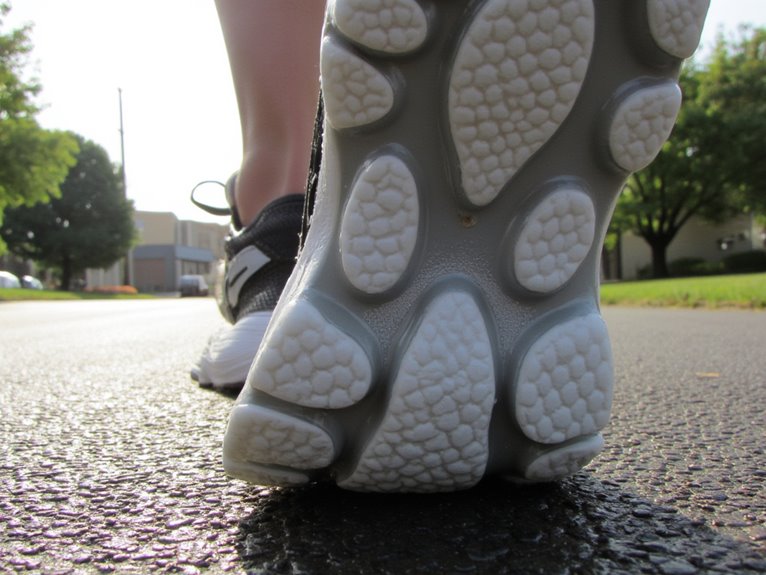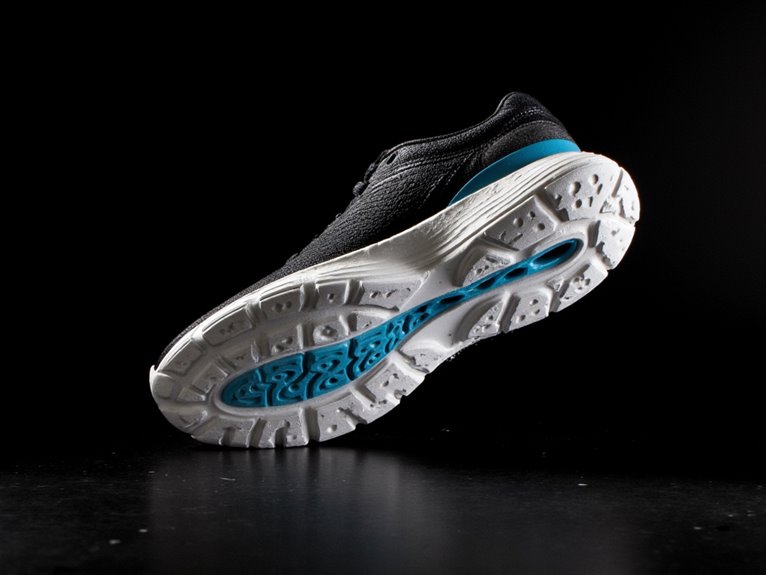Shock Absorption in Running Shoes: Does It Really Matter?
Shock absorption in running shoes absolutely matters, as you’ll experience 2.5 to 5 times your body weight in impact forces with each footfall. Quality midsole technology can reduce ground reaction forces by up to 40%, helping prevent injuries like plantar fasciitis. However, your shoes lose 25% of their cushioning after just 50 miles and retain only 60% effectiveness after 250-500 miles. Understanding these degradation patterns and performance factors will help you make smarter decisions for joint protection.
We are supported by our audience. When you purchase through links on our site, we may earn an affiliate commission, at no extra cost for you. Learn more. Last update on 28th November 2025 / Images from Amazon Product Advertising API.
Notable Insights
- Running impact forces reach 2.5-5 times body weight, making effective shock absorption crucial for preventing injuries like plantar fasciitis.
- Running shoe cushioning degrades significantly, losing 25% absorption after just 50 miles and over 40% by 250-500 miles.
- Your body naturally absorbs 85% of impact forces through muscle contractions and joint flexion, reducing reliance on shoes.
- Shoe material quality matters—softer foams provide better absorption but degrade faster, while harder materials last longer.
- Long-term joint health depends more on proper running form, strength training, and biomechanics than shoe cushioning alone.
Understanding the Science Behind Impact Forces and Cushioning Technology
The physics of running creates a relentless bombardment of force that your body must absorb with every footfall.
You’re generating impact forces between 2.5 to 5 times your body weight during initial contact and peak knee bend phases. These forces travel through your foot, ankle, knee, hip, and spine with devastating precision.
Running shoe manufacturers counter this assault through midsole technology.
EVA and polyurethane materials in your shoe’s midsole absorb and dissipate impact energy. Cushioning effectiveness depends on the material’s ability to deform under load without bottoming out. However, research reveals that shoe cushioning experiences a 25% drop in effectiveness after just 50 miles of use. Your running speed, terrain, body mass, and impact biomechanics all influence force magnitude.
Proper shock absorption reduces ground reaction forces, potentially preventing stress fractures, joint pain, and tendinopathies that plague runners. Inadequate shock absorption can lead to plantar fasciitis and other debilitating foot conditions that sideline even dedicated athletes.
How Your Running Shoes Lose Their Protective Power Over Time
Cushioning materials begin deteriorating from your very first run, launching an invisible countdown that steadily erodes your shoe’s protective capabilities.
Your midsole loses approximately 25% of its shock absorption after just 50 miles. This degradation accelerates rapidly—by 150 miles, you’ve lost 30-33% of original cushioning capacity.
EVA foam breaks down through repeated compression cycles, creating permanent deformation that can’t recover. Superior cushioning shoes often degrade faster due to softer materials that fatigue more quickly.
Three essential factors affect cushioning longevity:
- Material composition – EVA foam loses resiliency with each impact
- Running biomechanics – Your gait pattern influences wear patterns
- Environmental conditions – Temperature and humidity accelerate breakdown
Real-world testing shows 20-30% cushioning loss after 300-400 miles, making midsole replacement timing vital for maintaining protective function. Each running step generates forces of 2.5 to 5 times your body weight, creating enormous stress that even fresh shoe cushioning cannot fully absorb.
Key Factors That Determine Your Shoe’s Shock Absorption Performance
Your shoe’s shock absorption performance depends on three critical factors that directly affect how well your footwear protects you from impact forces.
The hardness level of your sole materials determines cushioning effectiveness, with softer EVA foams absorbing 15-25% more impact energy than firmer polyurethane compounds.
Your body weight considerably influences shock absorption demands, as heavier runners generate impact forces up to 5 times their weight at heel strike, requiring shoes with higher-density midsole materials and increased stack heights.
Proper insole design plays a crucial role in shock absorption since insoles maintain direct contact with your foot and serve as the primary interface for impact protection. Additionally, moisture-wicking properties in your shoe’s materials help maintain comfort during high-intensity running by preventing overheating and reducing fatigue that can compromise your natural shock absorption mechanics.
Sole Hardness Levels
Durometer readings tell the complete story about how your running shoe’s midsole will handle impact forces. Shore C measurements typically range from 50 to 70, directly affecting sole compression and your cushioning balance.
Understanding hardness levels helps you select best performance:
- Soft soles (50 Shore C) – Maximum compression reduces peak pressure but accelerates material breakdown
- Medium soles (60 Shore C) – Deliver highest user satisfaction through balanced shock absorption and stability
- Hard soles (70 Shore C) – Extend impact duration while reducing loading rates, though feeling less cushioned
Your biomechanics interact with sole hardness to determine injury risk. Softer materials deform more under impact, lowering foot pressure but potentially causing instability.
Medium hardness typically provides ideal cushioning balance for most runners, while harder compounds sacrifice comfort for durability and energy return.
Material Quality Types
EVA foam dominates the running shoe market****, but three distinct material categories determine how effectively your shoes absorb impact forces.
EVA foam provides lightweight cushioning but suffers from structural degradation over time. Its internal void volume diminishes with repeated compression, reducing shock absorption effectiveness.
Adding BIIR improves hardness and mechanical strength.
GEL materials deliver superior performance variations, offering 20% better shock absorption than equal-volume EVA while weighing 50% less. These thermoplastic elastomers increase elasticity by 10% and excel at dissipating impact forces.
TPU represents advanced cushioning innovations, comprising 40% of domestic shoe material markets. Linear TPU provides excellent comfort while maintaining structural integrity under mechanical stress better than EVA.
Your material choice directly impacts the compression-control tradeoff, affecting both cushioning effectiveness and motion stability.
Body Weight Impact
Impact forces during running create a complex relationship between your body weight and your shoe’s ability to absorb shock effectively. When you strike the ground, forces ranging from 2.5 to 5 times your body weight transmit through your joints and muscles. Higher body mass amplifies these loads considerably.
Your running shoes lose vital cushioning capacity over time. After 50 miles, they retain only 75% of their original shock absorption. This degradation accelerates with heavier runners due to increased repetitive loading.
Consider these key factors for ideal shock absorption:
- Shoe replacement frequency – Heavier runners need more frequent replacements to maintain adequate protection
- Midsole thickness – Greater cushioning compensates for increased impact forces from higher body weight
- Running mechanics – Proper form reduces effective impact forces regardless of your weight
Your body’s natural shock absorption system remains more essential than footwear alone.
The Truth About Marketing Claims vs. Real-World Protection
You’ve likely seen marketing campaigns promising revolutionary shock absorption that’ll transform your running experience, but the biomechanical reality tells a different story.
Running shoe manufacturers heavily emphasize cushioning technology as the primary solution for impact protection, yet research shows that shoes provide only limited reduction in peak impact forces during actual running.
Your body’s natural shock absorption system—comprising muscles, tendons, and joints—plays a far more critical role in protecting you from impact than any foam or gel technology built into your shoes.
Marketing vs. Reality
When you walk into any running store, you’ll encounter bold marketing claims about revolutionary cushioning technology that promises to transform your running experience and reduce injury risk.
These marketing tactics create specific consumer perception patterns that don’t align with scientific evidence.
The reality reveals significant gaps between advertising promises and actual performance:
- Rapid deterioration: Shoes lose 25% of shock absorption after just 50 miles, contradicting claims of long-lasting protection
- Price disconnect: No correlation exists between shoe cost and sustained shock absorption effectiveness
- Biomechanics override: Your body’s natural shock absorption systems matter more than cushioning technology
Research shows that after 250-500 miles, shoes retain less than 60% of their initial cushioning capacity.
This deterioration occurs regardless of brand or price point, challenging fundamental marketing narratives about premium cushioning systems.
Limited Shoe Impact
Beyond these marketing misconceptions lies an uncomfortable truth: your expensive running shoes provide far less protection than you’ve been led to believe. When you’re running, impact forces reach 2.5 to 5 times your body weight with each heel strike. Even premium cushioning systems can’t adequately handle these massive loads.
| Miles Run | Shock Absorption Retained | Cushioning Effectiveness |
|---|---|---|
| 0-50 | 75% | Moderate decline |
| 100-150 | 67% | Significant degradation |
| 250-500 | 60% | Poor performance |
| 500+ | 70% (real-world) | Minimal protection |
Your shoe selection matters initially, but mechanical protection degrades rapidly regardless of price. Real injury prevention depends on your body’s biomechanical systems—muscles, tendons, and proper running form—not expensive foam technology that deteriorates within weeks.
Body’s Natural Role
Your body’s natural shock absorption system operates like a sophisticated hydraulic network, far surpassing anything shoe manufacturers can engineer. Your hips, knees, and ankles flex upon impact, allowing muscles to contract and compress like springs. This active absorption stores energy from ground forces, then releases it during propulsion.
Your muscle efficiency depends on three critical mechanisms:
- Active muscle contractions that absorb 85% of impact forces through coordinated joint flexion
- Fascia networks that distribute shock from feet to spine, preventing localized trauma
- Evolutionary adaptations like enlarged heel bones designed for high-impact loads
Your body mechanics rely on interconnected fascia and ligaments forming an integrated shock-distribution system. Proper joint angles and muscle coordination provide superior protection compared to shoe cushioning alone.
Training biomechanical efficiency strengthens this natural system.
Your Body’s Natural Shock Absorption System and Running Form
The human body operates as a sophisticated shock absorption system that far exceeds any running shoe’s capabilities. Your muscles, joints, and connective tissues work together to manage impact forces reaching 2.5 to 5 times your body weight during each footstrike.
Proper muscle function depends on coordinated contractions in your hips, knees, and ankles. These joints create a spring-like mechanism through controlled flexion upon landing. Your running mechanics directly influence shock attenuation effectiveness. Landing with sufficient joint flexion activates large muscle groups that absorb energy through eccentric contractions.
However, fatigue compromises this system markedly. Your neuromuscular coordination deteriorates during prolonged running, reducing force-generating capacity. This forces higher impact transmission to bones and tissues, increasing injury risk when your body’s primary shock absorption mechanism becomes impaired.
Making Smart Choices for Long-Term Joint Health and Injury Prevention

While shoe cushioning provides temporary impact reduction, protecting your joints over decades of running requires a thorough approach that extends far beyond footwear selection. Your running shoes lose 33% of their cushioning after just 150 miles, making them unreliable for long-term protection.
Focus on these evidence-based strategies:
- Strengthen supporting muscles around your joints to enhance natural shock absorption capabilities.
- Develop proper running posture with efficient biomechanics to minimize joint loading forces.
- Balance footwear flexibility with stability, choosing soles between 30° to 40° hardness for ideal cushioning.
Your musculoskeletal system serves as your primary shock absorber. Neuromuscular control and body alignment matter more than expensive cushioning technologies.
Replace shoes every 250-500 miles, but prioritize strength training and biomechanical improvements for sustainable joint health. Technologies like gel and foam cushioning provide essential shock absorption, but examining stack height differences can significantly affect your shoe’s support and cushioning level.
On a final note
You’ll maximize injury prevention by understanding that shock absorption works best when combined with proper running form and regular shoe replacement. Replace your shoes every 300-500 miles when midsole compression reaches 40-50% loss. Don’t rely solely on marketing claims—test shoes on concrete surfaces for 10-15 minutes before purchasing. Your body’s natural biomechanics handle most impact forces, so prioritize shoes that complement your gait pattern rather than over-engineered cushioning systems.

